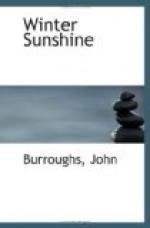I suspect that it is a little higher flight than the facts will bear out when the writers make the birds go out of sight into the sky. I could easily follow them on this occasion, though, if I took my eye away for a moment, it was very difficult to get it back again. I had to search for them as the astronomer searches for a star. It may be that in the spring, when the atmosphere is less clear and the heart of the bird full of a more mad and reckless love, that the climax is not reached until the eye loses sight of the singer.
Several attempts have been made to introduce the lark into this country, but for some reason or other the experiment has never succeeded. The birds have been liberated in Virginia and on Long Island, but do not seem ever to have been heard of afterwards. I see no reason why they should not thrive anywhere along our Atlantic seaboard, and I think the question of introducing them worthy of more thorough and serious attention than has yet been given it, for the lark is really an institution; and as he sings long after the other birds are silent,—as if he had perpetual spring in his heart,—he would be a great acquisition to our fields and meadows. It may be that he cannot stand the extremes of our climate, though the English sparrow thrives well enough. The Smithsonian Institution has received specimens of the skylark from Alaska, where, no doubt, they find a climate more like the English.
They have another prominent singer in England, namely, the robin,—the original robin redbreast,—a slight, quick, active bird with an orange front and an olive back, and a bright, musical warble that I caught by every garden, lane, and hedge-row. It suggests our bluebird, and has similar habits and manners, though it is a much better musician.
The European bird that corresponds to our robin is the blackbird, of which Tennyson sings:—
“O
Blackbird, sing me something well;
While all
the neighbors shoot thee round
I keep smooth
plats of fruitful ground
Where thou
may’st warble, eat, and dwell.”
It quite startled me to see such a resemblance,—to see, indeed, a black robin. In size, form, flight, manners, note, call, there is hardly an appreciable difference. The bird starts up with the same flirt of the wings, and calls out in the same jocund, salutatory way, as he hastens off. The nest, of coarse mortar in the fork of a tree, or in an outbuilding, or in the side of a wall, is also the same.
The bird I wished most to hear, namely, the nightingale, had already departed on its southern journey. I saw one in the Zoological Gardens in London, and took a good look at him. He struck me as bearing a close resemblance to our hermit thrush, with something in his manners that suggested the water-thrush also. Carlyle said he first recognized its song from the description of it in “Wilhelm Meister,” and that it was a “sudden burst,” which is like the song of our water-thrush.




